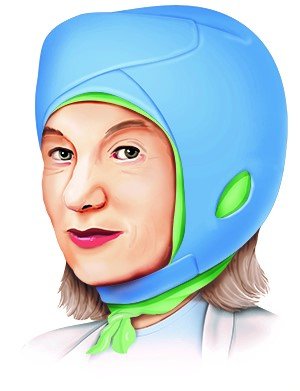Deutsche Krebsgesellschaft (DKG), Deutsche Krebshilfe (DKH), Arbeitsgemeinschaft der Wissenschaftlichen Medizinischen Fachgesellschaften (AWMF). Supportive Therapie bei onkologischen PatientInnen (S3-Leitlinie). AWMF-Registernr.: 032-054OL. 2020.
Hilton S, Hunt K, Emslie C et al. Have men been overlooked? A comparison of young men and women's experiences of chemotherapy-induced alopecia. Psychooncology 2008; 17(6): 577-583.
Rugo HS, Melin SA, Voigt J. Scalp cooling with adjuvant/neoadjuvant chemotherapy for breast cancer and the risk of scalp metastases: systematic review and meta-analysis. Breast Cancer Res Treat 2017; 163(2): 199-205.
Rugo HS, Voigt J. Scalp Hypothermia for Preventing Alopecia During Chemotherapy. A Systematic Review and Meta-Analysis of Randomized Controlled Trials. Clin Breast Cancer 2018; 18(1): 19-28.
Santos Z, Avci P, Hamblin MR. Drug discovery for alopecia: gone today, hair tomorrow. Expert Opin Drug Discov 2015; 10(3): 269-292.
Shah VV, Wikramanayake TC, DelCanto GM et al. Scalp hypothermia as a preventative measure for chemotherapy-induced alopecia: a review of controlled clinical trials. J Eur Acad Dermatol Venereol 2018; 32(5): 720-734.
Shaw J, Baylock B, O'Reilly A et al. Scalp cooling: a qualitative study to assess the perceptions and experiences of Australian patients with breast cancer. Support Care Cancer 2016; 24(9): 3813-3820.
Shen XF, Ru LX, Yao XB. Efficacy of scalp cooling for prevention of chemotherapy induced alopecia: a systematic review and meta-analysis. Eur Rev Med Pharmacol Sci 2021; 25(16): 5090-5103.
Shin H, Jo SJ, Kim DH et al. Efficacy of interventions for prevention of chemotherapy-induced alopecia: a systematic review and meta-analysis. Int J Cancer 2015; 136(5): E442-454. https://www.ncbi.nlm.nih.gov/pubmed/25081068
IQWiG health information is written with the aim of helping people understand the advantages and disadvantages of the main treatment options and health care services.
Because IQWiG is a German institute, some of the information provided here is specific to the German health care system. The suitability of any of the described options in an individual case can be determined by talking to a doctor. informedhealth.org can provide support for talks with doctors and other medical professionals, but cannot replace them. We do not offer individual consultations.
Our information is based on the results of good-quality studies. It is written by a team of health care professionals, scientists and editors, and reviewed by external experts. You can find a detailed description of how our health information is produced and updated in our methods.


